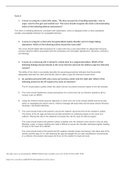Exam (elaborations)
Concordia University TexasForm A 1. A nurse is caring for a client who states, “My boss accused me of stealing yesterday. I was so angry I went to the gym and worked out.” The nurse should recognize the client is demonstrating which of the following defen
- Course
- NUR MISC
- Institution
- Concordia University ( )
Form A 1. A nurse is caring for a client who states, “My boss accused me of stealing yesterday. I was so angry I went to the gym and worked out.” The nurse should recognize the client is demonstrating which of the following defense mechanisms? The client is exhibiting behaviors consistent w...
[Show more]



